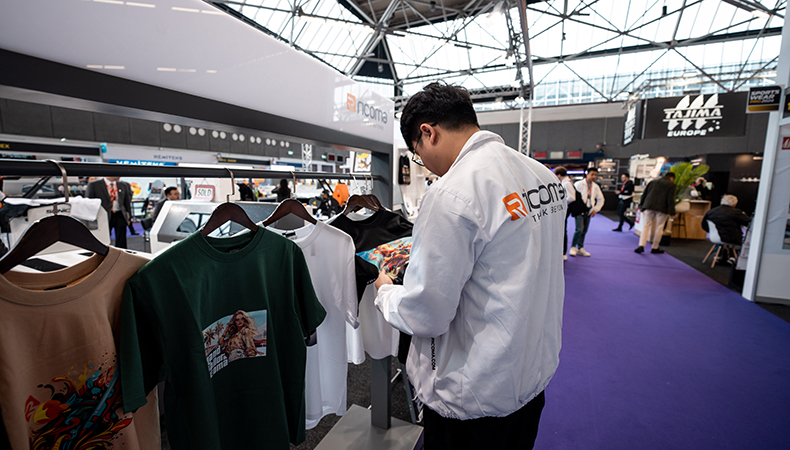Why print personalisation matters

FESPA’s Personalisation Experience Ambassador, Richard Askam, explains why it is vital that printers embrace the concept of personalisation.
Personalisation is a powerful innovation driver in the print industry – and retail in general – but it has the potential to be something far more lasting than just a passing trend. With artificial intelligence (AI) image generators such as Midjourney producing novel print-quality graphics, and the idea of mass production being superseded by the higher perceived value and more sustainable life of small run or even single-unit items, it is crucial that printers grasp the concept of personalisation.
To that end, FESPA has its very own Personalisation Experience Ambassador, Richard Askam – a man whose career has been in great part shaped by personalisation, albeit not initially in the print industry.
“My family background and business background is the wine industry, dating back to the 1950s with my dad. I was fortunate to spend 30 years of my life in that sector but when supermarkets started to move into that market and drive prices down, I could see the margin dropping away from that business. We needed to find a way to bring that margin back,” Richard says.
To achieve that, Richard started by creating bottles labelled specifically for individual restaurants and hotels, so that they could have own-branded house wine. That was then followed by a jump into personalised labels for gifting.

“Companies wanted to give gifts at Christmas for their staff or suppliers and they recognised that there was some value in personalising the label because that made it an individual thing, rather than everybody getting the same bottle of wine. That was my accidental venture into the world of personalisation from a corporate perspective,” Richard says.
“But around that time e-commerce was also beginning to grow. I took these personalised bottles to firms like Moonpig, John Lewis, Interflora, and set up the gifting category of personalised alcohol gifts.
“We were very much at the start of the personalised label business. At that point, I realised that it would be more beneficial for us to sell fewer products with more perceived value than trying to sell more products with no added value. That’s where the shift into personalised products happened.”
Coke comes calling
The success of personalisation with Richard’s family’s business led to him attracting the attention of the world’s biggest non-alcoholic drinks manufacturer: Coca-Cola. With Coke, Richard helped to deliver the iconic ‘Share a Coke’ campaign and, in the process, set himself on a new career path.
“Coke had seeded the campaign by distributing to shops bottles with 100 of the most popular names printed on the label, believing that would solve everything. Actually, that annoyed more people than it helped, so we created a website which allowed people to create their own label. It wasn’t truly unlimited – there was a database of 50,000 names – although the one name that absolutely wasn’t allowed was ‘Pepsi’! But the success of that campaign resonates to this day and it brought the concept of product personalisation to everybody’s consciousness,” Richard says. The Share A Coke campaign, which launched in 2012
The Share A Coke campaign, which launched in 2012
With the opportunity to give up the day job of – he says – “sticking labels on bottles”, Richard sold his business and went into consultancy and public speaking. Then, at an event in Brussels, Richard was approached by FESPA to promote personalisation within the print industry.
“My involvement with FESPA revolves around anything to do with personalisation or customisation. I create content that generates conversation, learning, education – there are still huge gaps in people’s understanding of what is possible,” Richard says.
One of the most significant gaps, Richards says, is in grasping just what personalisation is. It’s certainly not simply about putting people’s names on product labels.
“Your name is actually the least personal thing about you. If I wanted to send you something as a gift and I knew you well, I would reference a line from a song or something that was connected with a personal moment. It is quite obvious to me that there are still massive areas of the print industry that don’t understand that and think that by putting your name on a bar of chocolate, they have done personalisation – they haven’t,” Richard says.
“Really, personalisation is there to exploit the value of an emotional connection between two people. As human beings, we buy gifts for each other and then we stand in front of each other and watch as we unwrap them. We know what the gift is because we bought it, but we want to see the look on the person’s face who is receiving the gift when they open it. It’s that moment where personalisation acts as the trigger.
“The print industry has a huge advantage when it comes to deploying that emotional connection because it creates the print that delivers it.”
Keepsake industry
It’s not just by creating an emotional connection that personalisation has an upper hand; in the case of another great preoccupation of our time – ‘sustainability’ – personalised products have another great benefit.
“Personalisation is the perfect sustainable model because there is no waste. A vast amount of those Coca-Cola bottles we made were never opened. They weren’t bought as a drink; they were bought as a gift that happened to be a drink. The second you personalise something, it is never getting thrown away, so there is no landfill issue and you’ve only made one,” Richard says.
“We could think of personalisation as the keepsake industry, which brings about a huge opportunity for change. That is something that we cover on the FESPA’s Personalisation Experience podcast. My first question to a lot of people I speak to on that is: what does personalisation mean to you? The answer they give from a dad, mother, sister, brother perspective is entirely different to when they answer from a business owner perspective. As a business owner, they tend to only think about what they currently do, they don’t think about what they could do.
“There are some companies that are pushing the boundaries of innovation. But mainly what you see – in what is a very conservative print industry across the world – is people doing this year what they did five years ago, albeit less of it. That is what comes to be called ‘an elegant death’ because you are dying, but you just don’t notice it.”
Choose life
Crucial to surviving and thriving in the personalisation sector, Richard believes, is being able to deal with emerging cultural phenomena and technologies, such as AI, free from fear.
“I am involved in a personalised children’s book business called ‘You Are The Star’ and we are using AI to create the background images in the books, while we use artists to create the avatars. To date, AI is a little bit sporadic in its quality; it’s very good at painting skies but it doesn’t necessarily know that children don’t have six fingers!” Richard laughs.
“AI, for me, is just another tool in the toolbox of technology that has come along to help us. Some people will be scared of it just as there will always be people who want to get involved straight away. But technology is moving at such a speed and it’s never going to stop.
“Similarly, culture is always developing and I think the current world of co-branding is very interesting and very applicable to personalisation. I think young people want to see their name alongside a recognised brand – Nike, Adidas or whatever – and almost go into a joint venture with them, branding themselves alongside a recognised brand. We live in a world of Instagram, and branding is the most exciting thing there right now.
“But, for me, the most exciting thing hasn’t happened yet – that is what I am always looking for, the next big thing. The joy of my work with FESPA is that I get access to the potential. In many ways, the print industry is like one of those big recipe boxes where a food company sends you all the ingredients you need to put together a meal. I’m just looking at it, wondering, what if you forget the recipe and put the ingredients together in a different way – what could you create?”
Personalisation Experience, Europe's only event focused on personalisation in print to bring mass customisation will return to Berlin, Germany, from 6 to 9 May 2025 at Messe Berlin. Register your interest to visit here.
Become a FESPA member to continue reading
To read more and access exclusive content on the Club FESPA portal, please contact your Local Association. If you are not a current member, please enquire here. If there is no FESPA Association in your country, you can join FESPA Direct. Once you become a FESPA member, you can gain access to the Club FESPA Portal.
Recent news

Regulation guidance: Corporate Sustainability Reporting Directive
The Corporate Sustainability Reporting Directive (CSRD) is now in effect, but with further changes on the horizon, what does it mean for printers? Sustainability consultant Rachel England outlines everything you need to know and talks to Apigraf about how your business may be affected.

Web-to-print design: Canva versus Kittl
We look at popular design packages Canva and Kittl to determine how they compare regarding graphic design and print on demand.

FESPA in South Africa: the print skills to thrive
Printing SA’s Career Day inspired young Cape Town learners to explore printing and packaging careers.

The rise of Chinese printers
Chinese printing companies are on the rise, and have their eyes set on the UK and EU marketplace. Some have made an instant impact; others are running into issues with maintenance and language barriers. What does the future hold for Chinese printing firms, and how can you navigate working with them?